Question and Answer – December 2010
If you’d like Neil to help with a plant question, click to send it and the photo of the problem to Neil here at e-gardens. He chooses those of greatest reader interest and answers them in the next e-gardens. Since this is a visual medium, Neil rarely answers questions that are not accompanied by a photo. He welcomes your call to his radio programs for questions without photos. Also, please no plant ID questions here.
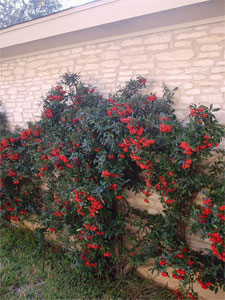
Question: I’d like to start about 500 yards of pyracantha along a current barbed wire fence on our ranch in DeLeon. There are cattle on the other side of the fence. Is there anything about the pyracantha that might be harmful to them? How can I get more plants started? Would they come up from these seeds on an old pyracantha on our house? J.B., Georgetown.
Answer: That’s a lot of pyracanthas to grow in a row. I’m assuming you’ll let them grow shrub-form and not try to train them along the fence? Training them would be monumental work. If things were to go right with your long planting, it could be stunning. However, pyracanthas are susceptible to lace bugs, leaf rollers, fire blight and cotton root rot. Any of the four issues could cause a serious problem with such a large planting. I do believe I’d break the planting up by using hollies, live oaks and other evergreens in groupings, along with pyracanthas. Pyracanthas are started from cuttings to ensure genetic purity. However, that requires a mist house and a bit of experience, plus it will take a year or two to get plants large enough to set out. All the while, you’ll have to train them. You’d be far better off to buy plants from a retail nursery. They would probably discount the price, since you’d be buying so many. I am not aware of any problems cattle have with them.
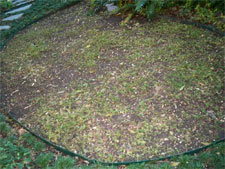
Question: This is a 5-year-old bed of moneywort that has not filled in well. It’s in shade during the growing season. We have two adjacent beds of dwarf mondograss and Asian jasmine, and they’ve done fine. Should I replace it, or is there something I could be doing differently? K.D.F., University Park.
Answer: I have nothing to suggest other than another groundcover. I’ve had the same experience with moneywort years ago. It seems fine for use between steppingstones, but it doesn’t make a good and solid groundcover plant, at least it didn’t for me. Dwarf mondo, which you’ve already used, is the only other groundcover that stays that short. My other chosen shade groundcovers of various heights are purple wintercreeper euonymus, aspidistra (tall), lamium (dead nettle – lovely, but assertive), liriope, variegated liriope, ferns and the various ivies.
Question: I divided a Mexican bush sage (Salvia leucantha), and these are the two plants that I got. Why the difference in their flowers? J.B., Abilene.
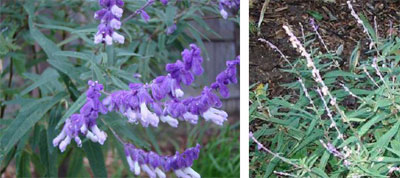
Answer: The flowers on the left look perfect. The flowers on the right look like they were at their prime a couple of weeks before this photo was taken. My best guess would be that the growing conditions might have been slightly different, or that one plant survived the division better than the other this first year. The time to divide them is late February. If you did it any later, that could account for the difference.
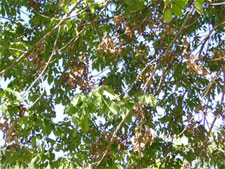
Question: What would be causing some of the lower limbs of my ash tree to die? E.C., Denison.
Answer: Borers are the typical answer anytime a question arises over any type of ash tree in Texas. Ashes are "magnetic" to the damaging insects. Check the trunk and branches for signs of holes with sawdust spilling out. Check the dead twigs, to see if there has been any type of chewing or gnawing damage done to them, perhaps by twig girdlers or some other insect. I can’t get much closer to an answer without being there, but these are probably pretty close. Sadly, we don’t have a good borer preventive insecticide.
Question: I have two maple trees in my back yard. They are about 20 years old and 35 feet tall. The smaller tree has bark that is peeling off, and it looks dead inside that area. Otherwise, the tree seems healthy. I took this photo before it lost its leaves a couple of weeks ago. B.D., Flower Mound.
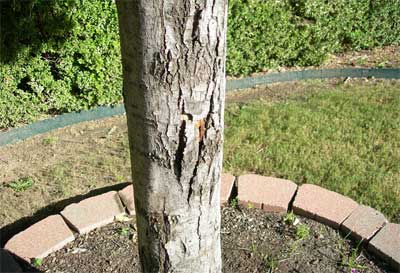
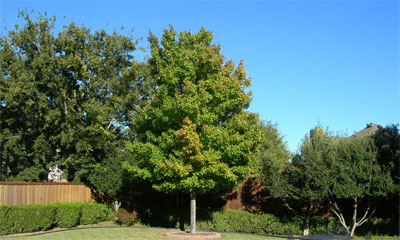
Answer: The tree, overall, looks fine. Bark is a dead tissue, and it sloughs off as the trunk grows and enlarges. However, this does look a bit odd. If the brown tissue you’re seeing beneath the loose bark is new bark that’s forming, all will be well. If there is active decay, however, you probably ought to call in a certified arborist to take a closer look. Lovely tree. It’s worth the fight.
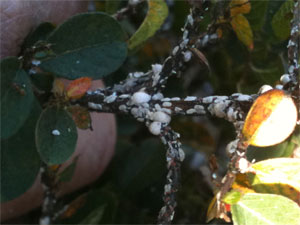
Question: I’m having trouble with my Pokomoke dwarf crape myrtle. What is this that’s growing on it? I thought it was supposed to be free of the sooty mold and the like. D., Aledo.
Answer: This is the new scale insect that has invaded Metroplex crape myrtles. Initially, it was just in the North Dallas suburbs, but it’s obviously spreading elsewhere. Luckily, it’s not been a serious threat every year. It seems to flourish during cloudy, rainy conditions. Hot weather usually slows its progress. You normally will see a growing population of lady bugs (black, with two orange dots on their backs) associated with the scale. They are very efficient in eliminating big numbers of the pest. A systemic insecticide spray would be the next best suggestion. We’ve only known about this pest for 5 years, but it does seem to be worse some years than others. It might be easiest now just to dip a foam paintbrush into rubbing alcohol and wipe it over the scales.
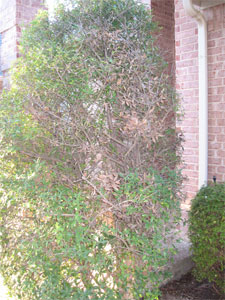
Question: We have two of these hollies planted on either side of our front door. They have really gone downhill this year, however. What might be causing this browning? They face south. Is there something I should be adding to their soil, or did they perhaps get too dry? D.L., North Richland Hills.
Answer: You have an unusual soil running through your part of the Metroplex (red, sandy clay loam). It’s perfect for most types of hollies. My guess would be that drought did get these two. I’m not sure if I’d try to salvage them. I’ve had great luck with Oakland (similar to the equally good Oakleaf) hollies. You might consider them as another option. Nice, large specimens are very affordable. I have some that are 10 years old and would still fit easily beneath eaves.
